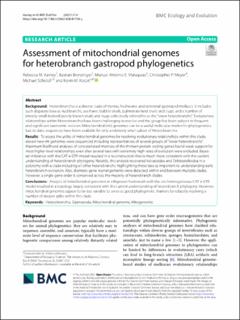Assessment of mitochondrial genomes for heterobranch gastropod phylogenetics
Varney, Rebecca M.; Brenzinger, Bastian; Malaquias, Manuel António E.; Meyer, Christopher P.; Schrödl, Michael; Kocot, Kevin M.
Journal article, Peer reviewed
Published version

Åpne
Permanent lenke
https://hdl.handle.net/11250/2982644Utgivelsesdato
2021Metadata
Vis full innførselSamlinger
- Department of Natural History [297]
- Registrations from Cristin [9791]
Sammendrag
Background
Heterobranchia is a diverse clade of marine, freshwater, and terrestrial gastropod molluscs. It includes such disparate taxa as nudibranchs, sea hares, bubble snails, pulmonate land snails and slugs, and a number of (mostly small-bodied) poorly known snails and slugs collectively referred to as the “lower heterobranchs”. Evolutionary relationships within Heterobranchia have been challenging to resolve and the group has been subject to frequent and significant taxonomic revision. Mitochondrial (mt) genomes can be a useful molecular marker for phylogenetics but, to date, sequences have been available for only a relatively small subset of Heterobranchia.
Results
To assess the utility of mitochondrial genomes for resolving evolutionary relationships within this clade, eleven new mt genomes were sequenced including representatives of several groups of “lower heterobranchs”. Maximum likelihood analyses of concatenated matrices of the thirteen protein coding genes found weak support for most higher-level relationships even after several taxa with extremely high rates of evolution were excluded. Bayesian inference with the CAT + GTR model resulted in a reconstruction that is much more consistent with the current understanding of heterobranch phylogeny. Notably, this analysis recovered Valvatoidea and Orbitestelloidea in a polytomy with a clade including all other heterobranchs, highlighting these taxa as important to understanding early heterobranch evolution. Also, dramatic gene rearrangements were detected within and between multiple clades. However, a single gene order is conserved across the majority of heterobranch clades.
Conclusions
Analysis of mitochondrial genomes in a Bayesian framework with the site heterogeneous CAT + GTR model resulted in a topology largely consistent with the current understanding of heterobranch phylogeny. However, mitochondrial genomes appear to be too variable to serve as good phylogenetic markers for robustly resolving a number of deeper splits within this clade.
